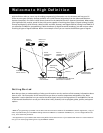
Setup and Connections
6
Step 1: Unpack the System
Make sure to locate the remote control and the other cables that are included with
your HD receiver.
Step 2: Connect Your HD Receiver to
Other Components
During the satellite dish antenna installation, your HD receiver may have been
connected with just a coaxial cable for the system test. Depending on the
components you have, another connection may provide better picture and audio
quality. The following sections provide cable and connection information to help you
decide what connection is best for you.
Things to Know Before Connecting Components
Protect Your Components from Power Surges
• Connect all components before plugging any power cords into the wall outlet.
• Always turn off the TV and other components before you connect or disconnect
any cables.
Position Cables Correctly to Avoid Audio Hum or Interference
• Insert all cable plugs firmly into their jacks.
• Place the Audio/Video cables to the sides of the TV’s back panel instead of
straight down the middle after you connect your components.
• Try not to coil any twin-lead cables; keep them away from the Audio/Video
cables as much as possible.
• Make sure all antennas and cables are properly grounded. Refer to the safety
sheet packed with your unit.
Protect Your Components from Overheating
• Do not block ventilation holes in any of the components. Arrange the
components so that air can circulate freely.
• Do not stack components.
• Allow adequate ventilation when placing your components in a stand.
• Place an amplifier on the top shelf of the stand so that heated air rising from it
will not flow around other components.
Remote Control
123
456
789
0
ON•OFF
TVVCR1
DVD
MUTE WHO
GO BACKFETCH
GUIDE INFO
MENU CLEAR
INPUT
REVERSE PLAY FORWARD
RECORD STOP PAUSE
ANTENNA
AUX
HD RCVR
OK
CH
+
CH
VOL
VOL
VCR2


















